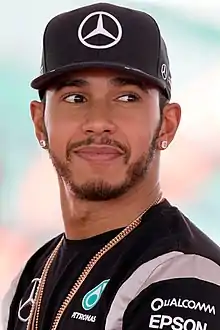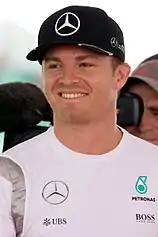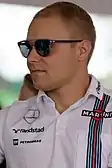2017 Formula One World Championship
The 2017 FIA Formula One World Championship was the 71st season of Formula One motor racing. It featured the 68th Formula One World Championship, a motor racing championship for Formula One cars which is recognised by the sport's governing body, the Fédération Internationale de l'Automobile (FIA), as the highest class of competition for open-wheel racing cars. Teams and drivers competed in twenty Grands Prix—starting in Australia on 26 March and ending in Abu Dhabi on 26 November—for the World Drivers' and World Constructors' championships.
| 2017 FIA Formula One World Championship |
|||
| Drivers' Champion: Lewis Hamilton Constructors' Champion: Mercedes Pole Trophy: Lewis Hamilton | |||
| Previous: | 2016 | Next: | 2018 |
| Support series: Formula 2 Championship GP3 Series | |||
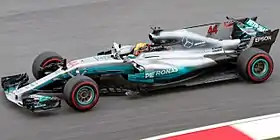
As the reigning Drivers' Champion Nico Rosberg announced his retirement from the sport in December 2016, the 2017 season was the first since 1994 in which the reigning champion did not compete.[1] Mercedes started the season as the defending Constructors' Champion, having secured their third consecutive title at the 2016 Japanese Grand Prix.[2]
At the conclusion of the championship, Lewis Hamilton won his fourth World Drivers' Championship title. Hamilton finished with 363 points, 46 points ahead of Sebastian Vettel in second with 317 points and Valtteri Bottas in third with 305 points.[3][4] In the World Constructors' Championship, Mercedes won their fourth consecutive title at the 2017 United States Grand Prix and finished with 668 points. Ferrari finished second with 522 points and Red Bull Racing were third with 368 points.[5]
Teams and drivers
The following teams and drivers took part in the 2017 Formula One World Championship.
Free practice drivers
Six drivers drove as free practice drivers over the course of the season. Alfonso Celis Jr. and George Russell both served as free practice driver for Force India. Antonio Giovinazzi, Sergey Sirotkin, Charles Leclerc and Sean Gelael served as free practice drivers for Haas, Renault, Sauber and Scuderia Toro Rosso respectively.
Team changes
- Just Racing, the parent company of MRT, went into administration in January 2017.[47] The company collapsed later that same month,[48][49] ultimately closing down entirely in March after administrators were unable to find a buyer for MRT.[50]
- Sauber used one year-old Ferrari power units in 2017, mirroring the arrangement between Ferrari and Scuderia Toro Rosso in 2016.[18]
- Toro Rosso returned to using Renault power units (badged with their own name) in 2017, having used 2015-specification Ferrari power units in 2016.[14] The team had previously used Renault power units in 2014 and 2015 before the relationship between Renault and sister team Red Bull Racing broke down, prompting Toro Rosso to seek out an alternative supplier.[51][52]
Driver changes
- Kevin Magnussen turned down an offer to stay with Renault and instead signed a deal with Haas to drive alongside Romain Grosjean.[10][53] As a result of the agreement with Magnussen and the team's decision to take up an option on Grosjean, Esteban Gutiérrez's contract with the team was not renewed.[54] Gutiérrez later moved to the Formula E championship.[55]
- Esteban Ocon moved from MRT to Force India, filling the seat left vacant by Nico Hülkenberg's departure to Renault.[56][57]
- Reigning champion and Mercedes driver Nico Rosberg announced his shock retirement from the sport at the end of the 2016 season when he clinched the title in Abu Dhabi.[1] Valtteri Bottas was released by Williams to sign with Mercedes as Rosberg's replacement.[58][59] Felipe Massa, who had intended to retire from Formula One at the end of the 2016 season,[60][61] extended his contract with Williams to replace his former teammate. Massa was partnered by 2016 European Formula 3 Championship winner Lance Stroll,[58] who was originally hired by the team to replace Massa.[62]
- 2015 GP2 Series champion Stoffel Vandoorne joined McLaren as a full-time driver.[63] Vandoorne previously competed in one race for the team, substituting for the injured Fernando Alonso at the 2016 Bahrain Grand Prix.[64] Vandoorne replaced Jenson Button, who took a sabbatical from racing in 2017 while staying on with the team as a reserve driver.[65]
- Pascal Wehrlein moved from the now-defunct MRT to replace Felipe Nasr at Sauber.[66]
Mid-season changes
- Sauber driver Pascal Wehrlein withdrew from the Australian Grand Prix as a precaution after an injury at the Race of Champions interrupted his training regime, prompting concerns that he would not be able to cope with the greater physical demands placed on the drivers by the 2017 generation of cars. As such, 2016 GP2 Series runner-up Antonio Giovinazzi took over racing duties for Sauber.[19][67] Wehrlein returned to competition at the Bahrain Grand Prix, with Giovinazzi resuming testing and reserve driving duties.[68]
- Fernando Alonso did not contest the Monaco Grand Prix. Instead, he participated in the Indianapolis 500.[30] Jenson Button, who was serving as team ambassador and reserve driver, replaced Alonso for the race.[32]
- Paul di Resta replaced Felipe Massa for the Hungarian Grand Prix after Massa was taken ill after Free Practice.[25]
- Jolyon Palmer was dropped by Renault after the Japanese Grand Prix. Carlos Sainz Jr., who was set to join Renault from 2018, left Toro Rosso early to replace him.[41]
- In the final rounds of the championship, Toro Rosso rotated several drivers between their cars. Prior to the Malaysian Grand Prix, Daniil Kvyat was replaced by 2016 GP2 Series champion Pierre Gasly. After Sainz Jr. left the team for Renault, Kvyat returned as his replacement for the United States Grand Prix. Gasly was forced to miss this race as it clashed with the final round of his Super Formula Championship campaign. FIA World Endurance Championship driver and former Red Bull Junior Team member Brendon Hartley stood in for him.[42][69][70][71] After the race, Kvyat was released from the team and from the Red Bull programme entirely, with Gasly returning to the team at the next race and Hartley being promoted to a regular race seat.[72][73]
Season calendar
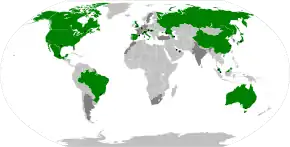
The following twenty Grands Prix took place in 2017:
Calendar changes
- The Baku event was renamed, becoming the first Azerbaijan Grand Prix.[75] The previous race at the Baku City Circuit ran under the European Grand Prix title in 2016.[75] The date of the race was changed to avoid conflicting with the 24 Hours of Le Mans, which had been a source of controversy at the 2016 European Grand Prix.[76]
- The Chinese and Bahrain Grands Prix swapped places in the schedule for the 2017 season. The Chinese Grand Prix became the second round of the 2017 season and was scheduled to take place on 9 April. This marked the earliest start ever in the Chinese Grand Prix history.
- The German Grand Prix was removed from the calendar after the owners of the Hockenheimring and Nürburgring circuits were unable to agree to commercial terms with Formula One Management.
Changes
General changes
- In September 2016, Liberty Media purchased a minority stake in the sport from CVC Capital Partners,[77] and completed the purchase ahead of the 2017 season,[78] with the long-term goal of adopting a model similar to that used by the U.S. National Football League and Major League Baseball, with teams entitled to purchase a stake in the sport.[79] The commercial operation of the sport underwent a restructuring in January 2017, with Bernie Ecclestone leaving his position as chief executive of Formula One Group after forty years in the role.[80] Former team principal Ross Brawn—who won World Championships with Ferrari and his own eponymous team—was appointed as Managing Director in Ecclestone's stead.[81]
- With the acquisition of the sport by Liberty Media, teams were given more control over creating and uploading content to social media.[82] Under Bernie Ecclestone's previous management, all footage filmed in the paddock was automatically controlled by Formula One Management with tight restrictions on the release of content.
- As a response to widespread changes in the technical regulations expected to increase cornering speeds by up to 40 km/h (24.9 mph), the FIA requested that every circuit on the calendar undergo revisions to update safety features.[83]
Technical regulations

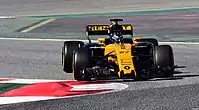
- The technical regulations governing bodywork design were revised for 2017, with the objective of improving lap times by four to five seconds over the 2016 generation of cars.[84] These changes include:[85]
- Overall width of the car increased from 1,800 mm (70.9 in) to 2,000 mm (78.7 in).[86]
- Bodywork width increased from 1,400 mm (55.1 in) to 1,600 mm (63.0 in).[86]
- Front wing width increased from 1,650 mm (65.0 in) to 1,800 mm (70.9 in).
- Rear wing lowered by 150 mm (5.9 in), from 950 mm (37.4 in) to 800 mm (31.5 in), and moved backwards by 200 mm (7.9 in).
- Rear diffuser height increased from 125 mm (4.9 in) to 175 mm (6.9 in) and width increased from 1,000 mm (39.4 in) to 1,050 mm (41.3 in), and leading edge moved from the rear wheel centre line to 175 mm (6.9 in) in front of it.[86]
- The leading edge of the barge boards was brought forward to allow teams more freedom in controlling airflow.
- Tyre width increased by 25% to allow cars to generate more mechanical grip. Front tyre width increased from 245 mm (9.6 in) to 305 mm (12.0 in) and rear tyre width increased from 325 mm (12.8 in) to 405 mm (15.9 in).[86]
- The minimum weight of the car including the driver was raised by 26 kg, from 702 kg to 728 kg.
- Maximum fuel consumed increased from 100 kg to 105 kg to account for the heavier, wider, and faster cornering cars.[87]
- 2017 saw teams adopt the "T-wing", a thin T-shaped wing mounted to the bodywork above and forward of the rear wing to generate additional downforce. Its creation prompted concerns about the use of moveable aerodynamic devices—forbidden under the rules—after several T-wings were observed to be vibrating during pre-season testing. However, the stewards chose to review the use of T-wings on a case-by-case basis rather than issue a technical directive.[88]
- The token system used to regulate power unit development—where the power unit was divided into individual areas, and each area assigned a points value with development of these areas deducting points from a manufacturer's overall points quota—will be abandoned.[89]
- Restrictions are to be placed on the dimensions, weight and the materials used to build each individual component of the power unit.[90]
- Teams are restricted to four power units per season regardless of the number of Grands Prix in the season.[91] Previous seasons had included a provision for a fifth power unit if the number of Grands Prix in a season exceeded twenty; from 2017, this provision is to be abandoned.
- The cost of a power unit supply is reduced by €1 million in 2017 ahead of a further reduction in 2018.[90]
- Cameras are no longer permitted to be mounted on stalks located on the nose of the car.[92]
- Pirelli continued to be Formula One's sole tyre supplier in 2017, beating out a bid by Michelin to provide tyres for the championship.[93] Continuing from previous seasons, the company offered a range of seven different tyre compounds, five for dry and two for wet conditions. While both wet compounds are available for every Grand Prix, only a choice of three dry compounds are made available to teams for a single race weekend.[94][95] As in the previous season, teams are allowed to choose ten out of thirteen sets of tyres for a race weekend freely from the three compounds made available by Pirelli. However, due to limited testing time for the new compounds during the winter break, Pirelli chose to provide teams with a mandatory number of sets for the first five races.[96]
Sporting regulations
- Under rules introduced in 2015, grid penalties for exceeding a driver's quota of power unit components carried over from one race to the next if the penalty could not be fully served when issued. When this carry-over system was abandoned, teams could build up a reserve of spare components by introducing several at once while only serving a single grid penalty. From 2017, teams will only be able to use one new component over their quota per race, with any additional components incurring further penalties. This change prevents teams from "stockpiling" spare power unit components.[97]
- Power unit suppliers will have an "obligation to supply", mandating that they supply power units to any team, should a team end up without an agreement.[89] The rule was introduced following the breakdown in the relationship between Renault and their customer teams Red Bull Racing and Scuderia Toro Rosso at the end of the 2015 season that left both teams in limbo until deals could be arranged.[98]
- In the event that a race is declared wet and must start behind the safety car, the grid will follow normal starting procedures once conditions are declared satisfactory for racing. Drivers will line up on the grid for a standing start once the safety car pulls into pit lane, although any laps completed behind the safety car will still count towards the total race distance.[99]
- The FIA abandoned the rule governing driving standards under braking, in lieu of an all-encompassing rule against manoeuvres that could endanger other drivers.[100] The rule was introduced in 2016 amid criticism of Max Verstappen for his habit of changing direction before braking late to defend his position, which led to concerns that such aggressive defensive driving could trigger an accident.[101]
- Starting from the Spanish Grand Prix, teams were required to display a driver's name and racing number on the external bodywork of the car in such a way that they are clearly visible to spectators. Teams have the option to use the official timing screen abbreviation; for example HAM (Hamilton) and VET (Vettel).[102]
Season report
The start of the season was tight with Sebastian Vettel leading the championship for the first 12 rounds and never by more than 25 points, however towards the end of the season Lewis Hamilton became dominant resulting in him taking the title at the Mexican Grand Prix with 2 races still to go. Hamilton was looking to regain the World Championship and his fourth overall while Vettel was looking to capture his first since 2013.[103]
Results and standings
Grands Prix
Scoring system
Points are awarded to the top ten classified finishers in every race, using the following structure:
| Position | 1st | 2nd | 3rd | 4th | 5th | 6th | 7th | 8th | 9th | 10th |
|---|---|---|---|---|---|---|---|---|---|---|
| Points | 25 | 18 | 15 | 12 | 10 | 8 | 6 | 4 | 2 | 1 |
In order for full points to be awarded, the race winner must complete at least 75% of the scheduled race distance. Half points are awarded if the race winner completes less than 75% of the race distance provided that at least two laps are completed.[N 8] In the event of a tie at the conclusion of the championship, a count-back system is used as a tie-breaker, with a driver's best result used to decide the standings.[N 9]
World Drivers' Championship standings
|
| ||||||||||||||||||||||||||||||||||||||||||||||||||||||||||||||||||||||||||||||||||||||||||||||||||||||||||||||||||||||||||||||||||||||||||||||||||||||||||||||||||||||||||||||||||||||||||||||||||||||||||||||||||||||||||||||||||||||||||||||||||||||||||||||||||||||||||||||||||||||||||||||||||||||||||||||||||||||||||||||||||||||||||||||||||||||||||||||||||||||||||||||||||||||||||||||||||||||||||||||||||||||||||||||||||||||||||||||||||||||||||||||||||||||||||||||||||||||||||||||||||||||||||||||||||||||||||||||||||||||||||||||||||||||||||||||||||||||||||||||||||||||||||||||||||||||||||||||||||||||||||||||||||||||||||||||||||||||||||||||||||||||||||||||||||||||||||||||||||||||||||
Notes:
 – Drivers did not finish the Grand Prix, but were classified as they completed more than 90% of the race distance.
– Drivers did not finish the Grand Prix, but were classified as they completed more than 90% of the race distance.
World Constructors' Championship standings
In the event of a tie at the conclusion of the championship, a count-back system is used as a tie-breaker, with a constructors's best result used to decide the standings.[N 9]
|
| |||||||||||||||||||||||||||||||||||||||||||||||||||||||||||||||||||||||||||||||||||||||||||||||||||||||||||||||||||||||||||||||||||||||||||||||||||||||||||||||||||||||||||||||||||||||||||||||||||||||||||||||||||||||||||||||||||||||||||||||||||||||||||||||||||||||||||||||||||||||||||||||||||||||||||||||||||||||||||||||||||||||||||||||||||||||||||||||||||||||||||||||||||||||||||||||||||||||||||||||||||||||||||||||||||||||||||||||||||||||||||||||||||||||||||||||||||||||||||||||||||||||||||||||||||||||||||||||||||||||||||||||||||||||||
Notes:
 – Drivers did not finish the Grand Prix, but were classified as they completed more than 90% of the race distance.
– Drivers did not finish the Grand Prix, but were classified as they completed more than 90% of the race distance.- The standings are sorted by best result, rows are not related to the drivers. In case of tie on points, the best positions achieved determined the outcome.
Notes
- Red Bull Racing used Renault R.E.17 power units. For sponsorship purposes, these engines were rebadged as "TAG Heuer".[15]
- Pascal Wehrlein was entered for the Australian Grand Prix but withdrew after taking part in free practice.[19]
- Scuderia Toro Rosso used Renault R.E.17 power units. For sponsorship purposes, these engines were rebadged as "Toro Rosso".[21]
- Brendon Hartley was entered in the United States Grand Prix as a replacement driver for Pierre Gasly and so carried the number 39 as it had been assigned to the team as a reserve number. With his entry in the next round in Mexico, Hartley became a regular driver and was entitled to choose his own number.
- When Daniil Kvyat raced for Toro Rosso for the United States Grand Prix, he drove the car that Carlos Sainz Jr. had previously competed in rather than the car he had driven in the first fourteen rounds of the championship.[22]
- When Pierre Gasly raced for Toro Rosso for the Mexican Grand Prix and the subsequent races, he drove the car that Carlos Sainz Jr. and Daniil Kvyat had previously competed in rather than the car he had driven in the fifteenth and sixteenth round of the championship.[23]
- Felipe Massa was entered for the Hungarian Grand Prix but withdrew after taking part in free practice.[25]
- In the event that two laps cannot be completed, no points are awarded and the race is abandoned.[104]
- In the event that two or more drivers or constructors achieve the same best result an equal number of times, their next-best result will be used. If two or more drivers or constructors achieve equal results an equal number of times, the FIA will nominate the winner according to such criteria as it sees fit.[104]
References
- "Nico Rosberg retires: World champion quits Formula 1 five days after title win". British Broadcasting Corporation. 2 December 2016. Archived from the original on 2 December 2016. Retrieved 2 December 2016.
- "Rosberg wins in Japan as Mercedes seal constructors' crown". Formula1.com. 9 October 2016. Archived from the original on 10 October 2016. Retrieved 9 October 2016.
- "Lewis Hamilton wins fourth world title at Mexican Grand Prix". BBC Sport. 29 October 2017. Archived from the original on 31 October 2017. Retrieved 31 October 2017.
- "Results". Formula1.com. Formula One World Championship Limited. Archived from the original on 23 October 2017. Retrieved 23 October 2017.
- "Results". Formula1.com. Formula One World Championship Limited. Archived from the original on 9 November 2017. Retrieved 23 October 2017.
- Baretto, Lawrence (24 February 2017). "Ferrari unveils its SF70H 2017 Formula 1 car". Autosport. Motorsport Network. Archived from the original on 3 May 2017. Retrieved 24 February 2017.
- "Ferrari launch the SF70H". Formula1.com. Formula One World Championship Limited. 24 February 2017. Archived from the original on 24 February 2017. Retrieved 24 February 2017.
- "Sahara Force India on Twitter". Twitter. 13 February 2017. Archived from the original on 12 March 2017. Retrieved 13 February 2017.
- "Mercedes-AMG Petronas Motorsport launches W08 EQ Power+". Mercedes-AMG Petronas Motorsport. 23 February 2017. Archived from the original on 4 April 2019. Retrieved 23 February 2017.
- "Haas F1 Team Secures 2017 Driver Lineup by Signing Kevin Magnussen to Join Romain Grosjean". Haas F1 Team. Archived from the original on 27 March 2019. Retrieved 11 November 2016.
- "McLaren announce new car name". Formula1.com. 3 February 2017. Archived from the original on 26 July 2018. Retrieved 3 February 2017.
- "McLaren Formula 1 – McLaren-Honda MCL32 Technical Specification". mclaren.com. Archived from the original on 2 September 2017. Retrieved 27 April 2017.
- "Time to Power into the Future". Red Bull Racing. 25 November 2016. Archived from the original on 4 August 2017. Retrieved 25 November 2016.
- Baretto, Lawrence (29 May 2016). "Red Bull and Toro Rosso F1 teams sign Renault engine deal". autosport.com. Haymarket Publications. Archived from the original on 30 May 2016. Retrieved 29 May 2016.
- "Red Bull to run TAG Heuer-badged Renault engines in 2016". Formula1.com. Formula One World Championship Limited. 4 December 2015. Archived from the original on 1 March 2017. Retrieved 1 March 2017.
- "R.S.17". Renault Sport. Archived from the original on 20 June 2018. Retrieved 21 February 2017.
- "Sauber F1 signs former Ferrari and Renault engineer". This Is F1. www.thisisf1.com. 4 September 2016. Archived from the original on 4 August 2017. Retrieved 1 November 2016.
- Barretto, Lawrence (8 October 2016). "Sauber will use year-old Ferrari engines for 2017 F1 season". Autosport. Haymarket Publications. Archived from the original on 8 October 2016. Retrieved 8 October 2016.
- Noble, Jonathan (25 March 2017). "Australian GP: Sauber F1's Pascal Wehrlein replaced by Giovinazzi". Autosport. Motorsport Network. Archived from the original on 25 March 2017.
- "Kvyat to stay at Toro Rosso for 2017". GPUpdate.net. JHED Media BV. 22 October 2016. Archived from the original on 22 October 2016. Retrieved 22 October 2016.
- "2017 Australian Grand Prix – Entry List" (PDF). FIA.com. Fédération Internationale de l'Automobile. 23 March 2017. Archived from the original on 23 March 2017.
- "Hartley, Hulkenberg, Vandoorne all set for grid penalties". Formula1.com. Formula One World Championship Limited. 20 October 2017. Archived from the original on 20 October 2017. Retrieved 20 October 2017.
- "Übersicht: Eingesetzte Power Unit-Elemente in der Saison 2017". Motorsport-Magazin.com. Redaktion Motorsport-Magazin.com. 29 October 2017. Archived from the original on 27 June 2017. Retrieved 30 October 2017.
- Medland, Chris (1 November 2016). "Williams to name 2017 car FW40 as part of anniversary". F1i.com. Archived from the original on 26 September 2018. Retrieved 1 November 2016.
- Noble, Jonathan (29 July 2017). "Paul di Resta replaces ill Felipe Massa at Williams for Hungary F1". Autosport.com. Motorsport Network. Retrieved 29 July 2017.
- Collantine, Keith (17 June 2016). "Pirelli confirms new three-year F1 deal to 2019". RaceFans. Retrieved 26 July 2016.
- "2017 F1 Entry List". Fédération Internationale de l'Automobile. Archived from the original on 2 March 2017. Retrieved 2 March 2017.
- "2017 Australian Grand Prix – Stewards' decision document 14". Fédération Internationale de l'Automobile. 25 March 2017. Archived from the original on 25 March 2017.
- "2017 China Grand Prix – Entry List". Fédération Internationale de l'Automobile. 6 April 2017. Archived from the original on 6 April 2017.
- "Fernando Alonso to race at Indy 500 with McLaren, Honda and Andretti Autosport". mclaren.com. McLaren Honda. 12 April 2017. Archived from the original on 20 May 2017.
- "2017 Bahrain Grand Prix – Entry List". Fédération Internationale de l'Automobile. 13 April 2017. Archived from the original on 13 April 2017.
- "Jenson Button to race at Monaco for McLaren-Honda". mclaren.com. McLaren Honda. 14 April 2017. Archived from the original on 20 April 2017.
- "2017 Russian Grand Prix – Entry List". Fédération Internationale de l'Automobile. 27 April 2017. Archived from the original on 27 April 2017.
- "2017 Monaco Grand Prix – Entry List". Fédération Internationale de l'Automobile. 24 May 2017. Archived from the original on 27 April 2017.
- "2017 Austrian Grand Prix – Entry List". Fédération Internationale de l'Automobile. 6 July 2017. Archived from the original on 6 July 2017.
- "2017 British Grand Prix – Entry list". Fédération Internationale de l'Automobile. 13 July 2017. Archived from the original on 13 July 2017.
- "2017 Hungarian Grand Prix – Entry List". Fédération Internationale de l'Automobile. 27 July 2017. Archived from the original on 27 July 2017.
- "2017 Singapore Grand Prix – Entry List". Fédération Internationale de l'Automobile. 14 September 2017. Archived from the original on 15 September 2017.
- "2017 Malaysian Grand Prix – Entry List". Fédération Internationale de l'Automobile. 28 September 2017. Archived from the original on 28 September 2017.
- "F1 - 2017 Updated Entry List". Fédération Internationale de l'Automobile. 29 September 2017. Archived from the original on 23 January 2018.
- "Renault Sport Formula One Team confirms driver change". Renault F1. Renault Sport. Archived from the original on 8 October 2017. Retrieved 7 October 2017.
- "Brendon Hartley to race with us in Austin". scuderiatororosso.com. Scuderia Toro Rosso. 13 October 2017. Archived from the original on 13 October 2017. Retrieved 13 October 2017.
- "2017 United States Grand Prix – Entry List". Fédération Internationale de l'Automobile. 19 October 2017. Archived from the original on 20 October 2017.
- "2017 Mexican Grand Prix – Entry List". Fédération Internationale de l'Automobile. 26 October 2017. Archived from the original on 27 October 2017.
- "2017 Brazilian Grand Prix–Entry List". Fédération Internationale de l'Automobile. 9 November 2017. Archived from the original on 24 November 2017.
- "2017 Abu Dhabi Grand Prix-Entry List". Fédération Internationale de l'Automobile. 23 November 2017. Archived from the original on 24 November 2017.
- "Formula One: British-based team Manor goes into administration". abc.net.au. Australian Broadcasting Corporation. 7 January 2017. Archived from the original on 7 January 2017. Retrieved 7 January 2017.
- "Manor F1 team collapse after administrators fail to find buyer". Sky Sports. Archived from the original on 29 January 2017. Retrieved 27 January 2017.
- Benson, Andrew (27 January 2017). "Manor F1: Team fold after administrator fails to find buyer". BBC Sport. Archived from the original on 27 January 2017. Retrieved 28 January 2017.
- Noble, Jonathan; Rencken, Dieter (1 March 2017). "Final Manor Formula 1 team rescue hopes end as 2017 entry withdrawn". autosport.com. Archived from the original on 1 March 2017. Retrieved 1 March 2017.
- "Red Bull will quit F1 if they don't get a competitive engine in 2016". Sky Sports. 18 September 2015. Archived from the original on 20 September 2015. Retrieved 18 February 2015.
- "Toro Rosso hush on engine talks". Fox Sports Asia. Fox Sports. 19 September 2015. Archived from the original on 29 September 2015. Retrieved 21 September 2015.
- Anderson, Ben; Parkes, Ian; Straw, Edd. "Kevin Magnussen: Renault F1 2017 offer not good enough". Autosport. Haymarket Publications. Archived from the original on 12 November 2016. Retrieved 11 November 2016.
- "Esteban Gutierrez confirms departure from Haas F1 Team at end of season". 11 November 2016. Archived from the original on 12 November 2016. Retrieved 11 November 2016.
- Smith, Sam. "Ex-Haas Formula 1 driver Gutierrez seals Formula E switch". autosport.com. Archived from the original on 10 January 2017. Retrieved 10 January 2017.
- "Esteban Ocon joins Sahara Force India for 2017 and beyond". Sahara Force India F1 Team. Archived from the original on 13 November 2016. Retrieved 10 November 2016.
- "Nico Hülkenberg joins Renault Sport Formula One Team". Renault Sport F1. Archived from the original on 14 October 2016. Retrieved 14 October 2016.
- "Felipe Massa to replace Valtteri Bottas for 2017 season". Williams Grand Prix Engineering. 16 January 2017. Archived from the original on 18 January 2017. Retrieved 16 January 2017.
- "Valtteri Bottas to partner Lewis Hamilton at Mercedes in 2017 season". BBC Sport. 16 January 2017. Archived from the original on 16 January 2017. Retrieved 16 January 2017.
- Benson, Andrew (1 September 2016). "Felipe Massa: Williams driver to retire from F1". bbc.com. Archived from the original on 2 September 2016. Retrieved 1 September 2016.
- Barretto, Lawrence (1 September 2016). "Felipe Massa to retire from Formula 1 at end of 2016 season". autosport.com. Archived from the original on 2 September 2016. Retrieved 1 September 2016.
- "Williams confirms driver line-up for the 2017 season". Williams Grand Prix Engineering. 3 November 2016. Archived from the original on 3 November 2016. Retrieved 3 November 2016.
- Beer, Ben Anderson and Matt. "Jenson Button to step down from McLaren F1 race seat in 2017". Archived from the original on 6 September 2016. Retrieved 3 September 2016.
- "Vandoorne: I maximised my opportunity". www.formula1.com. Archived from the original on 13 September 2016. Retrieved 10 September 2016.
- "Button to take Formula 1 sabbatical in 2017". speedcafe.com. 4 September 2016. Archived from the original on 3 August 2017. Retrieved 4 September 2016.
- Barretto, Lawrence (16 January 2017). "Sauber F1 team signs Pascal Wehrlein for 2017 season". autosport.com. Archived from the original on 16 January 2017. Retrieved 16 January 2017.
- SauberF1. "Preview – 2017 Formula One Heineken Chinese Grand Prix & Gulf Air Bahrain Grand Prix". Archived from the original on 4 April 2017. Retrieved 3 April 2017.
- Howard, Tom (12 April 2017). "Wehrlein returns for Bahrain Grand Prix". speedcafe.com. Archived from the original on 13 April 2017. Retrieved 13 April 2017.
- "Hartley, Hulkenberg, Vandoorne all set for grid penalties". Formula1.com. Formula One World Championship Limited. 20 October 2017. Archived from the original on 21 October 2017. Retrieved 22 October 2017.
- "Motor racing – Sainz to replace Palmer, Kvyat returns for Austin". sbs.com.au. SBS. 7 October 2017. Archived from the original on 12 October 2017. Retrieved 12 October 2017.
- "Gasly to miss Austin F1 race for Super Formula". Motorsport.com. Archived from the original on 12 October 2017. Retrieved 13 October 2017.
- "Pierre Gasly to drive with Scuderia Toro Rosso". scuderiatororosso.com. Scuderia Toro Rosso. Archived from the original on 26 September 2017. Retrieved 26 September 2017.
- "Daniil Kvyat no longer part of Red Bull or Toro Rosso in Formula 1". Autosport. Motorsport Network. 27 October 2017. Archived from the original on 28 October 2017. Retrieved 27 October 2017.
- "FIA Announces World Motorsports Council decisions". Fédération Internationale de l'Automobile. 30 November 2016. Archived from the original on 30 November 2016. Retrieved 30 November 2016.
- "No German Grand Prix on F1 2017 calendar but Azerbaijan race is official". The Guardian. Reuters. 30 November 2016. Archived from the original on 1 December 2016. Retrieved 30 November 2016.
- Collantine, Keith (2 February 2016). "No wonder FOM arranged Baku to clash with Le Mans". F1 Fanatic. Keith Collantine. Archived from the original on 15 May 2016. Retrieved 16 May 2016.
- "Formula One sells for $5.7 billion to John Malone's Liberty Media". abc.net.au. Australian Broadcasting Corporation. 8 September 2016. Archived from the original on 9 September 2016. Retrieved 8 September 2016.
- "Liberty completes F1 acquisition". Formula1.com. 23 January 2017. Archived from the original on 28 December 2017. Retrieved 24 January 2017.
- Parkes, Ian (8 September 2016). "Liberty Media's F1 takeover: Teams will get the chance to invest". autosport.com. Haymarket Publications. Archived from the original on 9 September 2016. Retrieved 8 September 2016.
- "Bernie Ecclestone no longer F1 chief executive – statement". Sky News. Archived from the original on 14 February 2019. Retrieved 23 January 2017.
- "Brawn and Bratches join F1 in sporting and commercial roles". Formula 1. 23 January 2017. Archived from the original on 2 February 2017. Retrieved 26 March 2017.
- "Formula One relaxes social media rules under post-Bernie Ecclestone regime as testing begins". abc.net.au. Australian Broadcasting Corporation. 28 February 2017. Archived from the original on 28 February 2017. Retrieved 28 February 2017.
- "FIA requests upgrades to F1 circuits for 2017". speedcafe.com. 18 January 2017. Archived from the original on 10 September 2017. Retrieved 18 January 2017.
- "F1 rules: elimination qualifying confirmed for Australia, 2017 cars "five seconds faster"". James Allen on F1. James Allen. Archived from the original on 5 March 2016. Retrieved 6 March 2016.
- Tyson, Will (11 May 2016). "Side-by-side: How the 2017 rules will change F1 design". F1 Fanatic. Keith Collantine. Archived from the original on 10 May 2016. Retrieved 11 May 2016.
- "2017 season changes". Formula1.com. Formula One World Championship Limited. Archived from the original on 12 March 2017. Retrieved 11 March 2017.
- Noble, Jonathan (30 April 2016). "Formula 1 raises fuel limit for 2017". www.motorsport.com. Archived from the original on 28 August 2019. Retrieved 28 August 2019.
- van Leeuwen, Andrew; Mitchell, Scott (24 March 2017). "Haas F1 team ordered to remove its T-wing in Australian GP practice". Autosport. Motorsport Network. Archived from the original on 25 March 2017. Retrieved 31 March 2017.
- "FIA confirms new 2017 engine regulations". speedcafe.com. 30 April 2016. Archived from the original on 7 August 2017. Retrieved 30 April 2016.
- Allen, James (29 April 2016). "Aanalysis: Important deal agreed on F1 engines to 2020". James Allen on F1. James Allen. Archived from the original on 30 April 2016. Retrieved 30 April 2016.
- Parkes, Ian; Barretto, Lawrence (12 May 2016). "How Formula 1's new engine rules will work". autosport.com. Haymarket Publications. Archived from the original on 16 May 2016. Retrieved 15 May 2016.
- "FIA announces World Motor Sport Council decisions". 30 September 2015. Archived from the original on 2 October 2015. Retrieved 2 October 2015.
- Galloway, James (12 October 2015). "Pirelli to stay as F1's sole tyre supplier until 2019 season". Sky Sports. Archived from the original on 1 March 2017. Retrieved 1 March 2017.
- "F1 Tires Range". Pirelli. Archived from the original on 2 March 2017. Retrieved 1 March 2017.
- "Tyres and wheels". Formula1.com. Formula One World Championship Limited. Archived from the original on 1 March 2017. Retrieved 1 March 2017.
- "Formel 1 – Neues Design, neue Regeln, schnellere Autos" (in German). Sportschau. 1 March 2017. Archived from the original on 1 March 2017. Retrieved 1 March 2017.
- Straw, Edd. "FIA closes Formula 1 engine penalty loophole". Archived from the original on 30 September 2016. Retrieved 28 September 2016.
- "Analysis: important deal agreed on F1 engines to 2020". jamesallenonf1.com. 29 April 2016. Archived from the original on 15 August 2016. Retrieved 15 September 2016.
- "Formula 1 agrees to lift controversial radio ban – Speedcafe". speedcafe.com. Archived from the original on 10 September 2017. Retrieved 30 July 2016.
- Cooper, Adam (23 March 2017). "FIA drops 'Max Verstappen rule' covering Formula 1 braking zones". Autosport.com. Motorsport Network. Archived from the original on 24 March 2017.
- "FIA clarifies rules on defensive manoeuvres". Formula1.com. Formula 1 World Championship Ltd. 22 October 2016. Archived from the original on 29 July 2017.
- Cooper, Adam (27 April 2017). "FIA reveals how F1 name and number displays rules will be enforced". Autosport.com. Motorsport Network. Archived from the original on 20 June 2017.
- "2017 season review - Hamilton proves 'four-midable'". www.formula1.com. Archived from the original on 15 July 2019. Retrieved 28 August 2019.
- "2017 Formula One Sporting Regulations". FIA.com. FIA. 9 March 2017. Archived from the original on 9 April 2017. Retrieved 9 April 2017.
- "2017 Abu Dhabi Grand Prix – Championship points". fia.com. Fédération Internationale de l'Automobile. 26 November 2017. Archived from the original on 3 September 2019.
